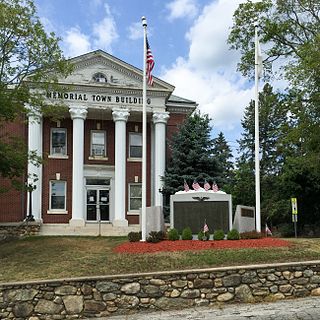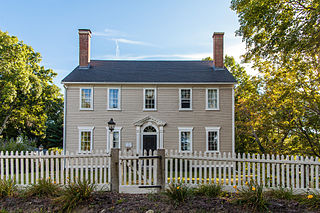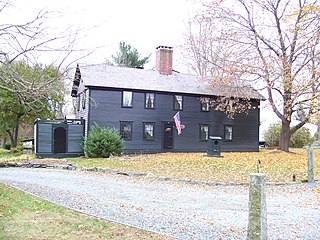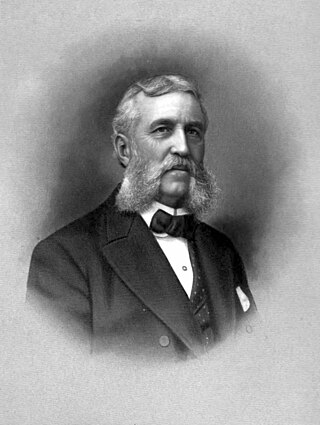
The Smithville Seminary was a Freewill Baptist institution established in 1839 on what is now Institute Lane in Smithville-North Scituate, Rhode Island. Renamed the Lapham Institute in 1863, it closed in 1876. The site was then used as the campus of the Pentecostal Collegiate Institute and later the Watchman Institute, and is now the Scituate Commons apartments. It was placed on the National Register of Historic Places in 1978.

The Eleazer Arnold House is a historic house built for Eleazer Arnold in about 1693, and located in the Great Road Historic District at Lincoln, Rhode Island. It is now a National Historic Landmark owned by Historic New England, and open to the public on weekends.

Slatersville is a village on the Branch River in the town of North Smithfield, Rhode Island, United States. It includes the Slatersville Historic District, a historic district listed on the National Register of Historic Places. The historic district has been included as part of the Blackstone River Valley National Historical Park. The North Smithfield Public Library is located in Slatersville.

Union Village or "Bank Village" is a village and historic district located in North Smithfield and Woonsocket, Rhode Island on Rhode Island Route 146A. Union Village developed because it was at the cross roads of old Great Road and Pound Hill Road.

This is a list of the National Register of Historic Places listings in Providence County, Rhode Island.

The Smith–Appleby House Museum is a historic house museum in Smithfield, Rhode Island. It is now home to the Smithfield Historical Society.

The Smithfield Road Historic District is a rural historic district in North Smithfield, Rhode Island, along Old Smithfield Road. It extends along Old Smithfield Road north from its junction with Sayles Hill Road, and is roughly bisected by Spring Brook. It includes eight historic houses or farmsteads, two 19th-century cemeteries, and a dam on Spring Brook just east of the road. The district encompasses a cross-section of the development of agricultural properties in North Smithfield over the 19th century, with properties dating from 1811 to 1932. The district covers 170 acres (69 ha), which includes lands currently and formerly in agricultural use.

The Smithfield Exchange Bank, built in 1822, is located on Putnam Pike in the Greenville area of Smithfield, Rhode Island.

The Smithfield Friends Meeting House, Parsonage and Cemetery, is a Friends Meeting House of the Religious Society of Friends (Quakers), rebuilt in 1881. It is located at 108 Smithfield Road in Woonsocket, Rhode Island. The meetinghouse is home to one of the oldest Quaker communities in the region.

Saint Thomas Episcopal Church is an Episcopal church located at 1 Smith Avenue in the village of Greenville in Smithfield, Rhode Island.

The Waterman–Winsor Farm is a historic farmhouse located in the Greenville part of Smithfield, Rhode Island.

The 1761 Milestone is a mile marker located at 640 South Main Street in Woonsocket, Rhode Island. The stone originally marked the junction of a Colonial highway from Great Road and an east-west route from Boston, Massachusetts to Connecticut. It was rediscovered during the installation of an electrical road. In 1898, it was restored to its original location by the local chapter of the Daughters of the American Revolution. The stone is embedded in a low retaining wall at the corner of South Main Street and Smithfield Road. It was added to the National Register of Historic Places on November 24, 1982, and is historically significant as a Colonial-era highway marker.

The William Mowry House is an historic farm house on Farnum Pike in North Smithfield, Rhode Island. It is a 2+1⁄2-story plank-framed house, five bays wide, with a gable roof and a large central chimney. The main entrance is centered on the main (south-facing) entry, and is enclosed within a single-story hip-roof vestibule of 20th-century construction. A small single-story ell extends to the west of the main block. The interior follows a typical center-chimney plan, with the kitchen and parlor in the front of the house, and the dining room flanked by a small pantry and bathroom in the rear. The house was built c. 1802-05 by William Mowry, whose family has owned land in the area since the 17th century.

Allenville Mill Storehouse is a historic mill storehouse at 5 Esmond Street in Esmond, Rhode Island within the town of Smithfield, Rhode Island. The exact date of construction is unknown, but it was built with rubble masonry construction which was typical of mill construction during and after the War of 1812. In 1813, Phillip Allen purchased 4.5 acres of land and constructed a mill on the site, but the first record to specifically refer to the storehouse was an insurance policy from 1836. Allen sold the property in 1857 and it changed ownership several times before it became Esmond Mills in 1906. In 1937, the building was used as a post office and described erroneously as the "Old Allenville Mill". The building has had some alterations to the front door and possibly the addition of a side door, but the interior of the structure was not detailed in the National Register of Historic Places nomination. The Allenville Mill Storehouse was added to the National Register of Historic Places in 1972.

The Angell–Ballou House is an historic house at 49 Ridge Road in Smithfield, Rhode Island, United States. The 2+1⁄2-story wood-frame structure was built c. 1800 for Jonathan Angell, a farmer and wheelwright. It is a well-preserved example of Federal style, with some high-quality woodwork and design elements more typical of Federal-style houses in sophisticated urban settings, but also showing some vernacular departures from the style. The house was sold in 1854 to Peter Ballou, in whose family it remained well into the 20th century.

The Captain Stephen Olney House is a historic site in North Providence, Rhode Island. It is a 2+1⁄2-story wood-frame structure, five bays wide, with a pair of interior chimneys. The principal exterior decoration is in the front door surround, which features pilasters supporting an entablature and gable pediment. The house was built in 1802 by Stephen Olney, a veteran of the American Revolutionary War, on what was then a large farm. His descendants enlarged the house in the 1840s, adding an ell to the south.

The Stephen Northup House is a historic house at 99 Featherbed Lane in North Kingstown, Rhode Island.

Edward I. Nickerson (1845–1908) was an American architect from Providence, Rhode Island, known for his work in the Queen Anne style in Providence.
This is a list of Registered Historic Places in North Smithfield, Rhode Island.
Waterman House may refer to:




















